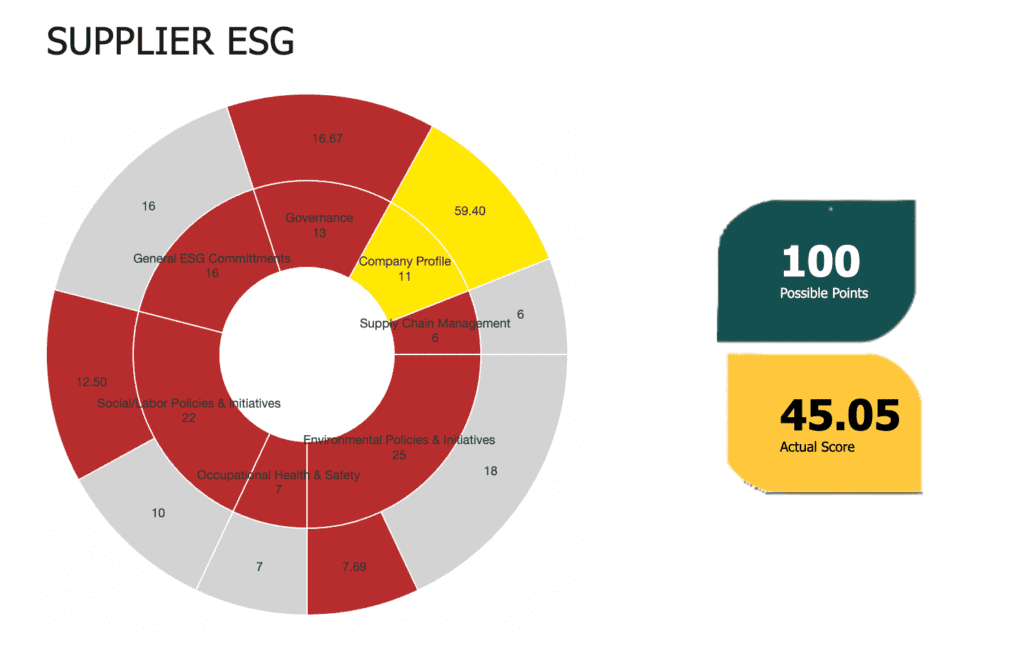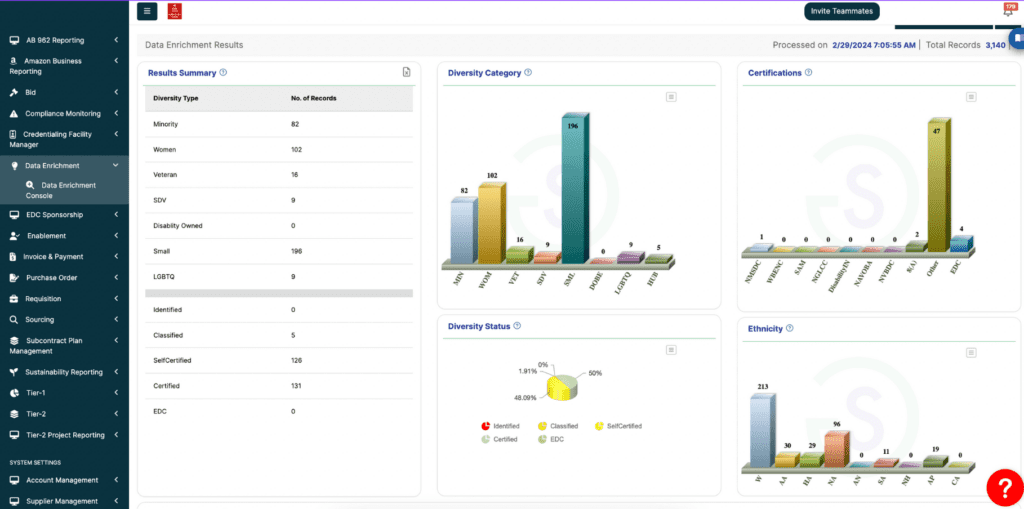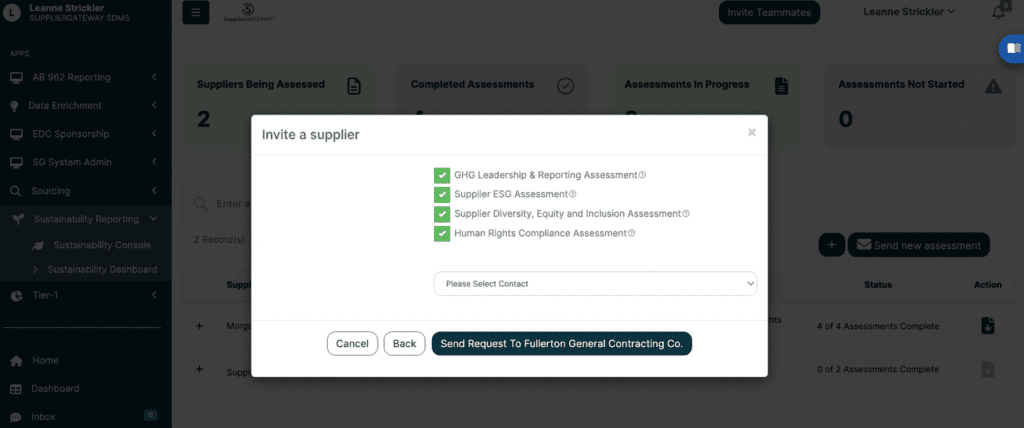What is EcoVadis: The Ultimate Guide
Click on the product you’re interested in learning about and get an interactive walkthrough.
How challenging is it to demonstrate your company’s corporate sustainability goals to clients and stakeholders?
As sustainability becomes a key factor in business decisions, companies without credible proof of their efforts risk losing valuable partnerships and contracts. The demand for transparency is growing, and businesses are under pressure to show concrete results.
Supply chain sustainability software like EcoVadis helps organizations measure and improve their environmental impact, but navigating these platforms can sometimes feel overwhelming and overly complex. Businesses often need a solution that’s not just comprehensive but also intuitive and cost-effective.
In this guide, we’ll break down what EcoVadis offers and help you understand its capabilities and limitations to determine if it’s the best choice—or if other EcoVadis alternatives might provide more adaptable and user-friendly solutions.
Key takeaways:
What Is EcoVadis?
EcoVadis is a global platform that provides sustainability ratings and assessments for businesses, helping them achieve their sustainable development goals.

In 2007, the founders of EcoVadis recognized the increasing need for companies to prove their commitment to sustainable procurement practices. The goal was to create a solution that could provide a reliable measure of corporate sustainability and the EcoVadis Assessment was born.
The platform utilizes a comprehensive methodology that is based on international sustainability standards, offering a clear and detailed scorecard for each company. These scorecards highlight strengths, call out areas for improvement, and provide industry benchmarks, making it easier for businesses to understand their sustainability standing.
Today, EcoVadis is used by over 130,000 companies across 180 countries. It helps businesses manage risk, improve sustainability performance, and enhance transparency in their supply chains. With a standardized approach to ESG assessment, EcoVadis supports businesses in making informed decisions and encourages a shift towards ethics and sustainable procurement.
Key Differentiators
EcoVadis positions itself as a leader in sustainability assessments, catering to businesses that want to demonstrate their commitment to ethical and sustainable practices. The platform’s key differentiator is its comprehensive, easy-to-understand scorecards, which offer clear insights into a company’s ESG performance. EcoVadis ensures that its assessments are credible and reliable by incorporating widely recognized international sustainability standards.
The platform also offers tools for continuous monitoring, allowing businesses to track their progress over time. This makes EcoVadis a valuable partner for companies looking to manage future risk and improve their sustainability efforts.
Sustainability assessments like those provided by EcoVadis are essential for businesses today. They help companies meet regulatory requirements, enhance their reputation, and build trust with customers and stakeholders, all of which are critical for long-term success.
Key Features
EcoVadis stands out in the market for its comprehensive and structured approach to sustainability assessments. Key features of the platform include:
- Global Reach: Provides sustainability ratings and assessments for companies worldwide, covering a broad range of industries and geographical regions.
- Comprehensive Scorecards: Offers detailed scorecards that evaluate performance across four key themes: Environment, Ethics, Labor & Human Rights, and Sustainable Procurement.
- Industry Benchmarks: Includes benchmarks that compare a company’s performance against industry peers, helping to contextualize results and identify areas for improvement.
- Continuous Monitoring: Allows for ongoing tracking of sustainability performance, enabling companies to stay updated and make necessary adjustments over time.
- Actionable Insights: Delivers practical recommendations and feedback based on the assessment, helping companies to address weaknesses and enhance their sustainability practices.
EcoVadis Pricing
EcoVadis pricing is not publicly available. Costs vary based on the size of the company, the scope of the assessment, and additional services required. Generally, pricing can range from a few thousand dollars to tens of thousands annually.
For precise pricing information, companies usually need to contact EcoVadis directly for a tailored quote based on their specific needs and scale.
See the Platform
Not quite ready to talk to someone but want to see what SupplierGateway platform have to offer? Click on the product you’re interested in learning about and get an interactive walkthrough.

How Does the EcoVadis Assessment Process Work?
EcoVadis uses a 4-step assessment process to provide a comprehensive look at a company’s sustainability practices.
Step 1: Registration
The first step in the certification process is to register on the EcoVadis website. During registration, users create a profile, which involves providing basic business information, such as the industry they operate in, their location, and key contact details. This initial setup is crucial as it helps tailor the assessment process to the specific needs and characteristics of the company.
Step 2: Questionnaire
After registering, users are required to complete a detailed questionnaire. This questionnaire is accessible through the EcoVadis online platform and is available in multiple languages to cater to a global user base.
The questionnaire covers various aspects of sustainability, including environmental impact, labor practices, ethical conduct, and supply chain management. Users are asked to provide specific information and documentation to support their responses, creating a complete overview of their sustainability practices.
Step 3: Expert Analysis
Once the questionnaire and supporting documents are submitted, they undergo a thorough review by EcoVadis experts. This analysis process typically takes about 6-8 weeks.
During this time, the experts carefully evaluate the information provided, checking the accuracy and relevance of the data against international sustainability standards. The goal is to provide an objective assessment of the company’s ESG performance.
Step 4: Results
After the analysis is complete, the results are delivered in the form of a detailed scorecard. The scorecard presents the answers from the questionnaire in a clear, organized format, highlighting the company’s strengths and improvement areas.ou minimize risks and build a reliable supply chain.

A sample of an EcoVadis scorecard.
It includes scores for each category of sustainability assessed, along with benchmarking data to show how the company compares to others in its industry. This feedback helps companies understand their current position and guides them in making informed decisions to enhance their sustainability efforts.
Subscribe
Get thought leadership, upcoming events, SupplierGateway product updates, and more directly in your inbox.
EcoVadis Rating Methodology
EcoVadis uses a detailed scoring system to evaluate a company’s sustainability performance, focusing on four key themes:
- Environment: Assesses a company’s efforts to minimize its environmental footprint, focusing on practices such as energy use, waste management, and resource conservation.
- Ethics: Evaluates the company’s commitment to ethical business practices, including anti-corruption measures, fair competition, and transparency.
- Labor and Human Rights: Examines how well a company respects and promotes labor rights and human rights, such as employee health and safety, working conditions, and non-discrimination policies.
- Sustainable Procurement: Looks at how a company manages its supply chain, emphasizing the integration of sustainability criteria in purchasing decisions and the ethical sourcing of materials.
The scoring system is divided into 21 areas of sustainability, ranging from customer health and safety to responsible information management.

EcoVadis’ 21 sustainability criteria.
The scoring is done on a scale of 0 to 100, with each theme receiving its own score, which then contributes to an overall score. Based on these scores, companies can earn the following EcoVadis Medals:
- Bronze Medal: Awarded to companies that meet the basic requirements in sustainability performance, demonstrating a foundational commitment to sustainable practices.
- Silver Medal: Given to companies that show good performance across the four key themes, indicating a more developed and proactive approach to sustainability.
- Gold Medal: Recognizes companies that exhibit excellent sustainability practices, performing significantly above average in all assessed themes.
- Platinum Medal: The highest recognition, awarded to companies that are leaders in sustainability, demonstrating outstanding performance and commitment across all four key themes.
Additionally, companies that excel in specific areas may receive EcoVadis Badges, which highlight particular strengths, such as leadership in environmental practices or ethical business conduct. These ratings and badges help companies understand their sustainability performance and effectively communicate their achievements to stakeholders., they are more likely to offer terms that are realistic and favorable.
Explore a Leading EcoVadis Alternative
SupplierGateway is a leading EcoVadis alternative, providing a more tailored and user-friendly approach to managing sustainability and supply chain performance. Key features of SupplierGateway’s sustainability assessments include:
- Supplier ESG Evaluation: Delivers an in-depth review of a company’s environmental, social, and governance practices, promoting supply chain transparency and effective risk management.
- Greenhouse Gas Leadership: Assess suppliers on carbon emissions, accuracy of measurements, reduction strategies, and support for greenhouse gas mitigation.
- Supplier DEI: Offers detailed information on diversity, equity, and inclusion initiatives, including commitment statements, diverse supplier status, and related programs.
Human Rights Compliance: Reviews labor practices to detect and address issues related to modern slavery and human trafficking, in line with international regulations.borative environment that is conducive to better results.

An example of SupplierGateway’s simple rating breakdown.
While EcoVadis offers custom, quote-based subscriptions, SupplierGateway opts for a more transparent pricing model. Each tier includes assessments, dashboard access, and reports. Prices vary based on quantity:
- 100 Assessments: $9,000/year.
- 1000 Assessments: $15,500/year.
- 2500 Assessments: $28,000/year.
- 5000 Assessments: $42,000/year.
- 10,000 Assessments: $68,000/year.
Businesses looking for additional features can also opt for the Corporate Social Responsibility Platform. It includes 100 assessments and capabilities like Tier-1 & Tier-2 tracking, economic impact reporting, diverse supplier search, and more.
Find Out More
Ready to see how SupplierGateway can transform your sustainability efforts? Book a demo today to explore our platform and discover how we can help you elevate your sustainability strategy.and objectivity.




















